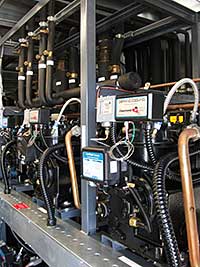EDITOR’S NOTE: The following article was prepared by GreenChill, the Advanced Refrigeration Partnership with the U.S. Environmental Protection Agency (EPA).
To meet our obligations under the Montreal Protocol, the United States is phasing out production of HCFC-22, an ozone depleting substance. Many food retailers are adapting to future R-22 supply constraints by transitioning away from this refrigerant. Retrofitting R-22-based commercial refrigeration systems to use substitute refrigerants is one transition option. Because most of these substitute refrigerants are potent greenhouse gases, it is important that food retailers use the retrofitting process as an opportunity to tighten system leaks.
Benefits

|
| On average, leaks cause a supermarket to emit approximately 1,000 pounds of refrigerant every year. Tightening leaks not only benefits the environment, it can produce significant cost savings. |
A typical supermarket refrigeration system holds a refrigerant charge of about 4,000 pounds and has an average annual leak rate of about 25 percent. Thus, on average, leaks cause a supermarket to emit approximately 1,000 pounds of refrigerant every year. Losing large quantities of refrigerant through leaks is expensive because of the need to replace the lost refrigerant. Tightening leaks can therefore produce cost savings. If every supermarket in the country joined GreenChill and reduced refrigerant emissions to the current GreenChill average, the industry would save an estimated $108 million annually.
Although HFCs, the key substitutes, are not ozone depleting substances, they are potent greenhouse gases, which can contribute to climate change when emitted. In order to achieve environmental benefits for both climate change and the ozone layer, it is critical to ensure leak tightness when retrofitting.
Resources
It is possible to obtain information on best practices for ensuring leak tightness during refrigeration system retrofits from several sources. The EPA’s ‘GreenChill Best Practices Guideline for Commercial Refrigeration Retrofits’ is a peer-reviewed guideline that provides best practices for retrofitting refrigeration systems that use R-22 to HFC substitute refrigerants. This guideline, which was co-authored by experts from several GreenChill partner companies (including Arkema, DuPont, Honeywell, and INEOS Fluor) and the EPA, includes a list off system conversion procedures that a typical food retailer would likely undertake to retrofit equipment that was originally designed to use R-22. Throughout this list of procedures, EPA identifies environmental best practices to ensure leak tightness. Appendix 2 of the guideline has conversion checklists for specific HFC substitute chemicals that also identify opportunities for verifying leak tightness.
The full guideline is available at www.epa.gov/greenchill/downloads/RetrofitGuidelines.pdf.
EPA has hosted a webinar on Environmental Best Practices for Retrofits. The webinar included presentations from representatives from four food retailers describing their experiences in retrofitting their stores’ refrigeration systems with ones that use HFCs. Included were measures they took to ensure leak tightness throughout the process. Presentation materials from this webinar and others are available at www.epa.gov/greenchill by clicking on the link “Past Events.”
Guidelines
The EPA developed the guideline to offer fact-based, objective information on best practices for retrofitting refrigeration systems that use R-22 to HFC substitute refrigerants. The document can assist a wide range of stakeholders in the food retail industry including strategic decision-makers, store managers, and technicians involved in the conversion process.
The guideline includes the following information:
• Reasons to consider retrofitting refrigeration equipment that uses R-22.
• Descriptions of HFC retrofit options currently available to food retailers.
• Descriptions of factors that should be considered when assessing substitute chemicals.
• Current best practices for transitioning to HFC substitutes and improving leak tightness.
• Recovery techniques, disposal, and reclamation options for R-22.
• Case studies that describe real-life examples of retrofits in the field.


Report Abusive Comment